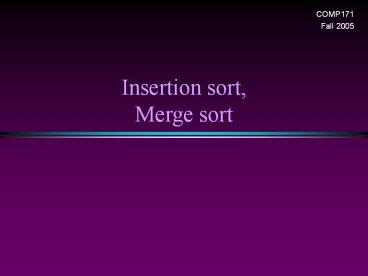Insertion sort, Merge sort - PowerPoint PPT Presentation
Title:
Insertion sort, Merge sort
Description:
... insertion sort runs fast Mergesort Based on divide-and-conquer strategy Divide the list into two smaller ... Dividing If the input list is a linked list, ... – PowerPoint PPT presentation
Number of Views:163
Avg rating:3.0/5.0
Title: Insertion sort, Merge sort
1
Insertion sort,Merge sort
COMP171 Fall 2005
2
Insertion sort
- 1) Initially p 1
- 2) Let the first p elements be sorted.
- 3) Insert the (p1)th element properly in the
list so that now p1 elements are sorted. - 4) increment p and go to step (3)
3
Insertion Sort
4
Insertion Sort...
see applet
http//www.cis.upenn.edu/matuszek/cse121-2003/App
lets/Chap03/Insertion/InsertSort.html
- Consists of N - 1 passes
- For pass p 1 through N - 1, ensures that the
elements in positions 0 through p are in sorted
order - elements in positions 0 through p - 1 are already
sorted - move the element in position p left until its
correct place is found among the first p 1
elements
5
Extended Example
To sort the following numbers in increasing
order 34 8 64 51 32 21
P 1 Look at first element only, no change.
P 2 tmp 8 34 gt tmp, so second element is
set to 34. We have reached the front of the list.
Thus, 1st position tmp After second pass 8
34 64 51 32 21
(first 2 elements are sorted)
6
P 3 tmp 64 34 lt 64, so stop at 3rd
position and set 3rd position 64 After third
pass 8 34 64 51 32 21
(first 3 elements are sorted)
P 4 tmp 51 51 lt 64, so we have 8 34
64 64 32 21, 34 lt 51, so stop at 2nd
position, set 3rd position tmp, After fourth
pass 8 34 51 64 32 21
(first 4 elements are sorted)
P 5 tmp 32, 32 lt 64, so 8 34 51 64 64
21, 32 lt 51, so 8 34 51 51 64 21,
next 32 lt 34, so 8 34 34, 51 64 21,
next 32 gt 8, so stop at 1st position and set 2nd
position 32, After fifth pass 8 32 34 51
64 21
P 6 tmp 21, . . . After sixth pass 8
21 32 34 51 64
7
Analysis worst-case running time
- Inner loop is executed p times, for each p1..N
- ? Overall 1 2 3 . . . N O(N2)
- Space requirement is O(N)
8
Analysis
- The bound is tight ?(N2)
- That is, there exists some input which actually
uses ?(N2) time - Consider input is a reverse sorted list
- When Ap is inserted into the sorted A0..p-1,
we need to compare Ap with all elements in
A0..p-1 and move each element one position to
the right - ? ?(i) steps
- the total number of steps is ?(?1N-1 i)
?(N(N-1)/2) ?(N2)
9
Analysis best case
- The input is already sorted in increasing order
- When inserting Ap into the sorted A0..p-1,
only need to compare Ap with Ap-1 and there
is no data movement - For each iteration of the outer for-loop, the
inner for-loop terminates after checking the loop
condition once gt O(N) time - If input is nearly sorted, insertion sort runs
fast
10
Mergesort
- Based on divide-and-conquer strategy
- Divide the list into two smaller lists of about
equal sizes - Sort each smaller list recursively
- Merge the two sorted lists to get one sorted list
- How do we divide the list? How much time needed?
- How do we merge the two sorted lists? How much
time needed?
11
Dividing
- If the input list is a linked list, dividing
takes ?(N) time - We scan the linked list, stop at the ?N/2? th
entry and cut the link - If the input list is an array A0..N-1 dividing
takes O(1) time - we can represent a sublist by two integers left
and right to divide Aleft..Right, we compute
center(leftright)/2 and obtain Aleft..Center
and Acenter1..Right
12
Mergesort
- Divide-and-conquer strategy
- recursively mergesort the first half and the
second half - merge the two sorted halves together
13
see applet
http//www.cosc.canterbury.ac.nz/people/mukundan/d
sal/MSort.html
14
How to merge?
- Input two sorted array A and B
- Output an output sorted array C
- Three counters Actr, Bctr, and Cctr
- initially set to the beginning of their
respective arrays - (1) The smaller of AActr and BBctr is
copied to the next entry in C, and the
appropriate counters are advanced - (2) When either input list is exhausted, the
remainder of the other list is copied to C
15
Example Merge
16
Example Merge...
- Running time analysis
- Clearly, merge takes O(m1 m2) where m1 and m2
are - the sizes of the two sublists.
- Space requirement
- merging two sorted lists requires linear extra
memory - additional work to copy to the temporary array
and back
17
(No Transcript)
18
Analysis of mergesort
- Let T(N) denote the worst-case running time
of mergesort to sort N numbers. - Assume that N is a power of 2.
- Divide step O(1) time
- Conquer step 2 T(N/2) time
- Combine step O(N) time
- Recurrence equation
- T(1) 1
- T(N) 2T(N/2) N
19
Analysis solving recurrence
Since N2k, we have klog2 n
20
(No Transcript)
21
An experiment
- Code from textbook (using template)
- Unix time utility

